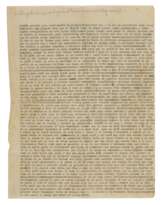Márquez, Gabriel García | Two typescripts for "La Siesta del Martes," with Márquez's manuscript corrections
08.12.2023 12:00UTC -05:00
Classic
Verkauft
25400USD $ 25 400
| Auctioneer | Sotheby´s |
|---|---|
| Veranstaltungsort | Vereinigten Staaten, New York |
Archiv
Die Auktion ist abgeschlossen. Es können keine Gebote mehr abgegeben werden.

ID 1111100
Los 65 | Márquez, Gabriel García | Two typescripts for "La Siesta del Martes," with Márquez's manuscript corrections
Schätzwert
$ 20 000 – 30 000
Two typescripts for "La Siesta del Martes," with Márquez's manuscript corrections, ca. 1962
19 pages (275 x 194 mm). Nine page ribbon typescript, with later draft 10 page carbon typescript, manuscript title to first page of ribbon typescript in pencil and in Márquez's hand, approximately 40 edits in pencil and ink to ribbon typescript also in Márquez's hand; some toning and staining, first page with some marginal loss. Housed in custom stab-stitched album and clamshell case.
A pair of typescripts for "La Siesta del Martes" — Márquez favorite amongst his short stories, with his pre-publication edits.
"La Siesta del Martes" ("Tuesday Siesta") was one of the short stories that appeared in Gabriel García Márquez's Los funerales de la mamá grande in 1962 (the volume was published in the United States in the same year as Big Mama's Funeral). Though the collection failed to garner much attention until after the appearance of One Hundred Years of Solitude in 1967, several of the stories in it are now regarded as the most accomplished examples of the form written in Latin America.
Márquez submitted "La siesta del Martes" to a short story contest sponsored by the Caracas newspaper El Nacional, but without any success. Despite this rejection, Márquez considered it to be his best short story. The narrative evolved out of a childhood memory of the author's. He recalled the scene of a woman and her daughter walking down a dry, dusty street in his native Aracataca on a hot afternoon. Each was dressed in black, and each carried flowers in their hands. At the time, someone had told the adolescent Márquez that the woman was the mother of a thief. The the impression the mother and daughter made on Márquez was apparently a formative one. Here, he writes:
"No había nadie en la estación. Del otro lado de la calle, en la acera sombreada por los almendros, sólo estaba abierto el salón de billar. El pueblo flotaba en el calor. La mujer y la niña descendieron del tren, atravesaron la estación abandonada cuyas baldosas empezaban a cuartearse por la presión de la hierba, y cruzaron la calle hasta la acera de sombra. Eran casi las dos. A esa hora, agobiado por el sopor, el pueblo hacía la siesta." (Page 3)
("There was no one at the station. On the other side of the street, on the sidewalk shaded by the almond trees, only the pool hall was open. The town was floating in the heat. The woman and the girl got off the train and crossed the abandoned station—the tiles split apart by the grass growing up between—and over to the shady side of the street. It was almost two. At that hour, weighted down by torpor, the town was taking a siesta.")
Here, as in the rest of the first typescript, Márquez has made minor textual edits, correcting the tense, striking through lines and clauses, and considering his word choice. In the final line of the above passage, for example, "calor" ("heat") is crossed out with pencil, and changed to "sopor" ("torpor"). The overall tone of the story is stark, and the sort of stillness or sense of stagnation that it engenders is a large part of what renders it so affecting. In an interview with Plinio Apuleyo Mendoza, Márquez acknowledged his debt to Ernest Hemingway for various technical aspects of "La siesta del Martes," the most apparent perhaps being Hemingway's "iceberg technique." Much is left unsaid, or remains understated, and the small yet meticulous edits made by Márquez demonstrate his attention to detail—his understanding that each word had to be exactly right in order to carry the most weight. The treatment of grief, class, and poverty in "La Siesta del Martes" is profoundly affecting, conveying a significant emotional depth in relatively few pages.
The second typescript reflects the emendations Márquez has made in the first, suggesting a lead up to publication in Los funerales de la mamá grande, as these changes are also reflected in the final published text.
An important typescript of a story that demonstrates Márquez's debt to Hemingway.
| Künstler: | Gabriel García Márquez (1927 - 2014) |
|---|---|
| Kategorie des Auktionshauses: | Drucke, Graphik, Bücher |
| Künstler: | Gabriel García Márquez (1927 - 2014) |
|---|---|
| Kategorie des Auktionshauses: | Drucke, Graphik, Bücher |
| Adresse der Versteigerung |
Sotheby´s 1334 York Avenue 10021 New York Vereinigten Staaten | ||||||||||||||
|---|---|---|---|---|---|---|---|---|---|---|---|---|---|---|---|
| Vorschau |
| ||||||||||||||
| Telefon | +1 212 606 7000 | ||||||||||||||
| Nutzungsbedingungen | Nutzungsbedingungen | ||||||||||||||
| Geschäftszeiten | Geschäftszeiten
|







